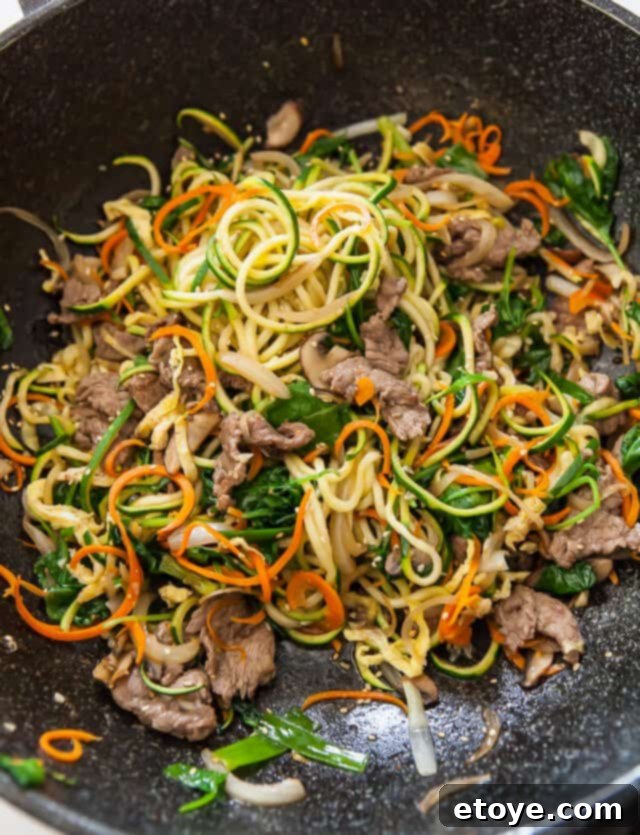Welcome to a culinary journey that transforms a classic into a vibrant, health-conscious delight! This Korean Zucchini Noodle recipe, often referred to as “Zoodles Japchae,” offers a fresh, low-carb twist on the beloved traditional Korean glass noodle dish. Imagine tender, spiralized zucchini noodles (zoodles) expertly mixed with perfectly seasoned slices of lean beef and an array of colorful, crisp vegetables, all brought together by an irresistible savory-sweet sauce. This isn’t just a meal; it’s a testament to how quick, easy, and incredibly flavorful healthy eating can be. Ready in just 10 minutes of active cooking time after a bit of prep, it’s the ultimate solution for a delicious weeknight dinner that doesn’t compromise on taste or nutrition.
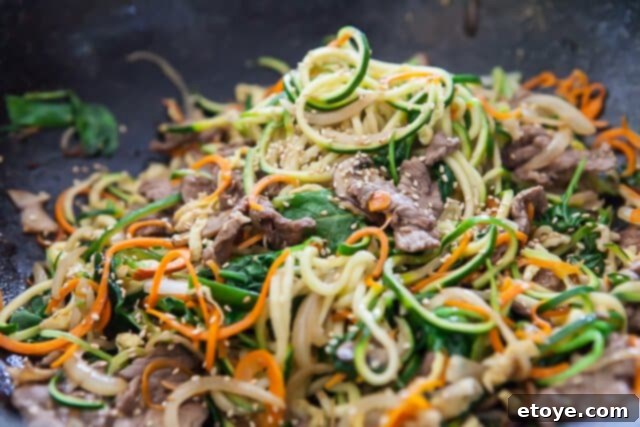
Why This Korean Zucchini Noodles Recipe is a Must-Try
Our Zoodles Japchae stands out for several compelling reasons, making it an instant favorite for anyone seeking a healthy, quick, and remarkably tasty meal.
- A Low-Carb, Gluten-Free Twist on Classic Japchae: This recipe ingeniously substitutes traditional sweet potato glass noodles with fresh zucchini noodles. The result is a significantly lower-carb, gluten-free dish that retains all the complex flavors of authentic Korean Japchae without the carb load, making it perfect for keto and paleo-friendly diets.
- Unparalleled Flavor and Texture: The secret to truly exceptional stir-fries lies in cooking each ingredient separately. This method, inspired by traditional Korean cooking techniques, ensures that every component – from the beef to the vegetables and the zoodles themselves – is cooked to perfection. This means no mushy zucchini, perfectly caramelized beef, and vibrant, distinct vegetable flavors that sing in every bite.
- Guaranteed Non-Mushy Zoodles: Overcooked zucchini noodles are a common pitfall. Our precise cooking method ensures your zoodles remain firm, slightly crisp, and perfectly al dente, absorbing the delicious sauce without turning into an unappetizing soggy mess.
- Effortless and Speedy: Despite its gourmet taste and appearance, this dish is surprisingly simple and incredibly fast to prepare. With minimal hands-on cooking time, it’s an ideal choice for busy weeknights when you crave something nutritious and satisfying without spending hours in the kitchen.
Essential Ingredients for Your Zoodles Japchae
Gathering your ingredients beforehand is key to a smooth and quick stir-fry experience. Here’s what you’ll need for this flavorful Korean Zucchini Noodles recipe:
- **For the Irresistible Sauce:** Soy sauce (or tamari for gluten-free), honey (or your preferred sweetener), and aromatic Asian sesame oil.
- **Protein Power:** Lean beef, thinly sliced for quick cooking and maximum flavor absorption.
- **Vibrant Veggies:** Fresh onion, zucchini (of course!), carrot, green onion, mushrooms, and nutrient-rich spinach.
- **For Garnish & Texture:** A single egg, beaten and cooked into a delicate crepe, and a sprinkle of toasted sesame seeds.
- **Cooking Basics:** A high-quality cooking oil (such as canola or vegetable oil).
Mastering Korean Zucchini Noodles: A Step-by-Step Guide
The beauty of this recipe lies in its methodical approach, ensuring each element shines. Follow these steps for a perfect Zoodles Japchae every time.
1. Prepare Your Noodles and Vegetables
First, grab your spiralizer. Using the 1/8-inch “spaghetti” setting, transform three medium zucchini into beautiful, long strands of zoodles. For easier handling and eating, you can gently cut these long strands into shorter, manageable lengths. Next, spiralize one small carrot using the same setting, then chop these carrot strands into 2-inch pieces. This initial preparation, known as ‘mise en place,’ is crucial for a smooth and swift cooking process, as stir-frying moves quickly.
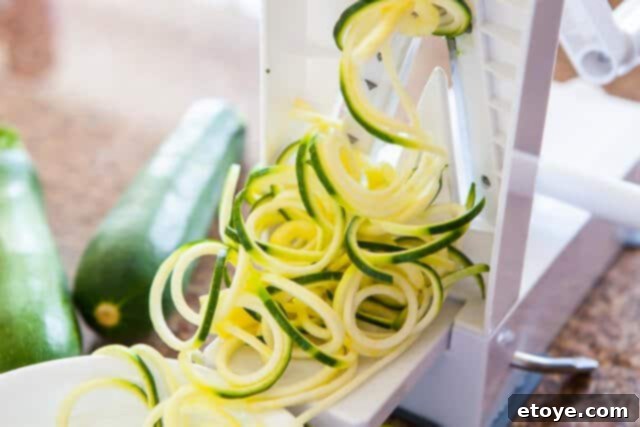

For this recipe, we’ll be cooking four distinct groups of ingredients separately to ensure optimal texture and flavor:
- The delicate Egg
- The crisp Vegetables
- The star: Zucchini Noodles
- The savory Meat + Onions
While this might seem like a few extra steps, rest assured, the individual cooking times are very short, and the entire dish comes together incredibly fast!
2. Marinate the Beef and Onions
Before any frying begins, let’s create the foundational flavor for our dish. In a small bowl, whisk together the soy sauce, honey, and Asian sesame oil to create our versatile stir-fry sauce. Now, in a separate medium bowl, combine your thinly sliced lean beef and the equally thin onion slices. Pour in just one-third of your prepared sauce mixture over the beef and onions, mixing thoroughly to ensure every piece is coated. Allow this mixture to marinate at room temperature while you prepare the remaining components of the recipe. This brief marination period infuses the beef with flavor and helps tenderize it, while also allowing the onions to absorb the delicious sauce, promoting faster caramelization during cooking.
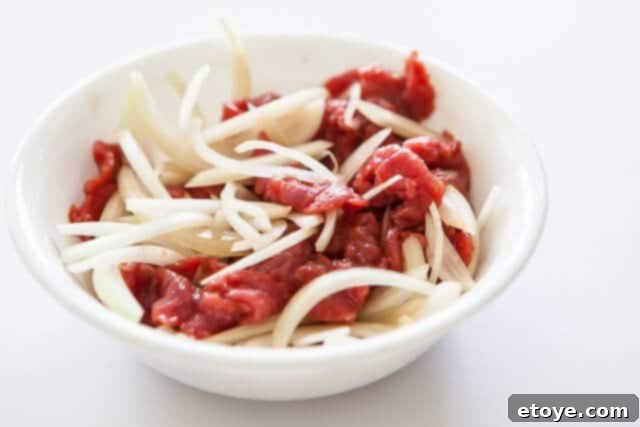
3. Fry the Egg Crepe
The first ingredient to kiss the hot pan is the beaten egg. Heat a non-stick wok or a large sauté pan with high sides over medium-high heat. Add just a tiny amount of cooking oil, swirling to coat the bottom. Once hot, pour in the beaten egg, immediately tilting the pan to spread the egg into a thin, even layer, much like making a delicate crepe. Cook until the edges are set and the bottom is lightly golden. Flip gently and cook the other side until firm. Remove the cooked egg crepe to a cutting board and julienne it into thin, elegant strips. These strips will add a lovely color, texture, and subtle richness to our finished dish. Place the julienned egg into a large serving bowl or platter, where it will await the other ingredients.
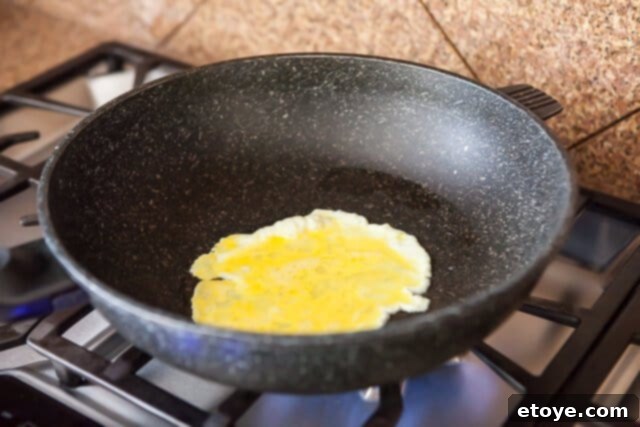

4. Stir-Fry the Vegetables
Return the same pan to the stove (no need to wash it; a quick wipe with a paper towel if desired is sufficient). Add a touch more cooking oil and heat it over medium-high heat. Begin by adding the green onions, finely minced garlic, sliced mushrooms, and spiralized carrots. Stir-fry these harder vegetables for about 30 seconds, just until the green onions become bright green and the carrots start to soften slightly but retain their crunch. Next, add the fresh baby spinach (or a baby spinach/kale mixture). Stir-fry for another 30 seconds until the greens have just wilted and turned a vibrant green. Pour in half of the *remaining* soy/honey/sesame oil sauce mixture and toss everything well to coat. Immediately remove the cooked vegetables to the large serving bowl, joining the julienned egg.



5. Stir-Fry the Zucchini Noodles
Clean the pan with a quick wipe and return it to medium-high heat with a little more cooking oil. Now, it’s time for the star of our dish: the zucchini noodles. Add the zoodles to the hot pan and stir-fry them very quickly. The goal is to cook them just until the dark green of their skin turns a bright, vivid green and they begin to appear slightly translucent, but critically, they should still retain some of their natural curl and shape. This quick, high-heat cooking prevents them from becoming mushy. Pour in the *last* of the soy/honey/sesame oil mixture and toss thoroughly to ensure the zoodles are evenly coated and absorb the delicious sauce. Taste a zoodle to confirm its perfect al dente texture. Remove the perfectly cooked zucchini noodles to a separate plate or bowl.



6. Stir-Fry the Marinated Meat and Onions
For our final separate component, return the same pan to the stove, swirl in a touch more cooking oil, and crank the heat up to HIGH. Add the marinated beef and onions to the pan. Crucially, spread the mixture out evenly over the entire surface of the pan. Resist the temptation to constantly toss or stir. Let the meat and onions cook undisturbed for 15-30 seconds. This allows for superior caramelization and a beautiful sear on the beef. Once the edges of the beef turn brown but the centers are still pink/red, flip the mixture and cook the other side until it reaches your desired doneness. This high-heat, undisturbed searing technique is key to locking in flavor and achieving tender, slightly crispy beef.

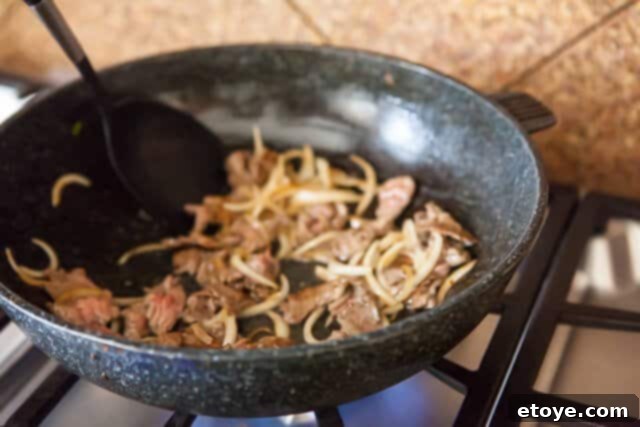
7. Bring It All Together and Serve
Now comes the satisfying grand finale! Return all the separately cooked ingredients – the julienned egg, the vibrant vegetables, the perfectly cooked zucchini noodles, and the savory beef and onions – back into the hot wok or pan. Toss everything together gently but thoroughly, allowing the flavors to meld beautifully. Give the dish a quick taste test and adjust seasoning with additional soy sauce if desired. Finally, sprinkle generously with toasted sesame seeds for an added layer of nutty flavor and visual appeal. Serve immediately and enjoy your freshly made, incredibly delicious Korean Zucchini Noodles!
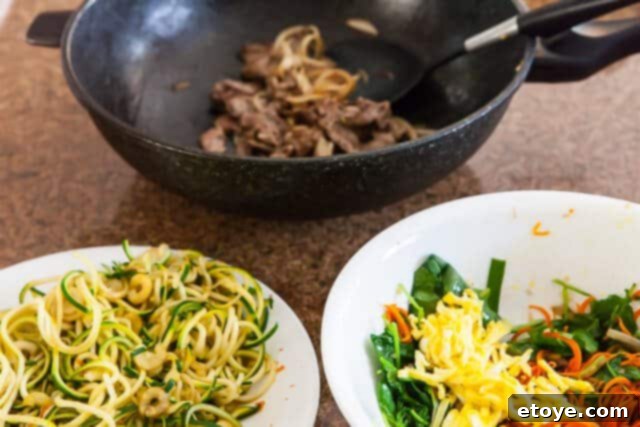
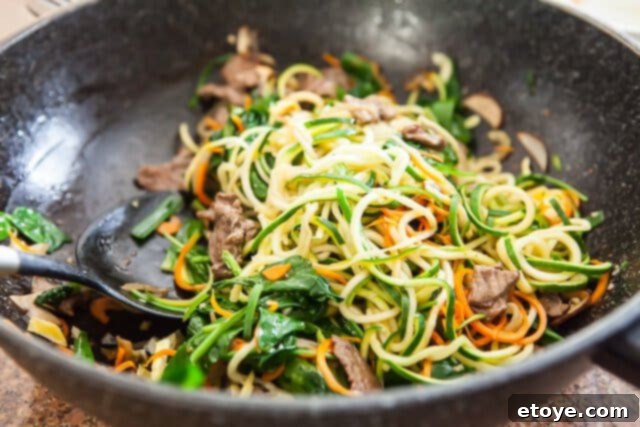
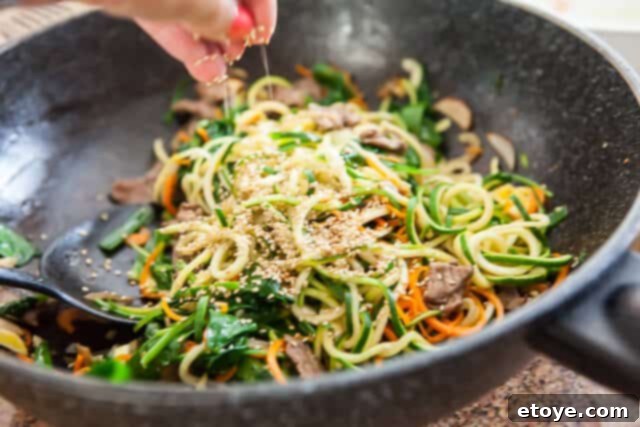
And there you have it – your exquisite Korean Zucchini Noodles, ready to be devoured!

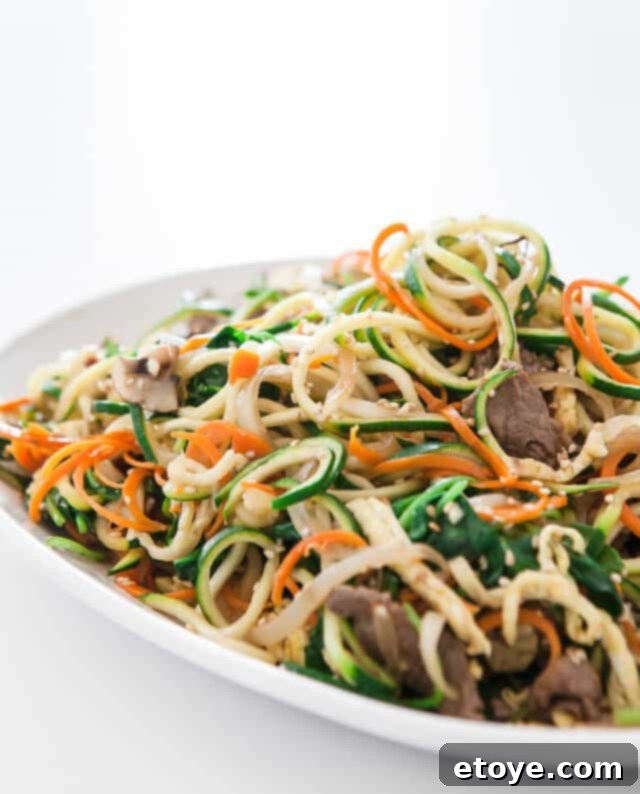
Pro Tips for Perfect Korean Zucchini Noodles
- Mastering the Zoodles: The key to non-mushy zucchini noodles is high heat and quick cooking. Avoid crowding the pan, which can steam the zoodles instead of stir-frying them. Cook until they are vibrant green and slightly translucent, but still firm and curly.
- The Art of Separate Cooking: This isn’t a mere suggestion; it’s a foundational technique for this dish. Cooking each ingredient group individually ensures optimal texture and prevents overcooking, especially for the delicate zoodles. It also allows each flavor to develop fully before combining.
- Mise en Place is Your Best Friend: Because stir-frying is a fast-paced cooking method, have all your ingredients prepped, chopped, and measured before you even turn on the stove. This organized approach guarantees a stress-free and successful culinary experience.
- Choosing Your Beef: Lean sirloin is an excellent choice for its tenderness and quick cooking time. Flank steak also works wonderfully; just remember to slice it thinly *across the grain* to maximize tenderness. For an even quicker option, some supermarkets offer pre-sliced steak, or you can even use ground beef for a different texture.
- Wok Alternatives: Don’t have a wok? No problem! A large, wide-bottomed sauté pan or a deep frying pan with high sides will work just as well. The main goal is to have enough surface area to allow ingredients to stir-fry rather than steam.
- Customization Ideas: Feel free to experiment with other vegetables like bell peppers, snap peas, or bok choy. For a vegetarian version, omit the beef and add extra mushrooms or firm tofu. Shrimp or chicken can also be fantastic protein substitutes.
Essential Equipment: Choosing the Right Spiralizer
The magic of zucchini noodles begins with a good spiralizer. There are several options available, each with its own advantages, depending on your needs and budget.
For those who occasionally enjoy zucchini or carrot noodles and prioritize affordability and compact storage, the Oxo Julienne Peeler is an excellent choice. This inexpensive tool, typically around $10, is easy to clean, fits neatly in a drawer, and efficiently creates long, thin julienne strips. While it might not produce the perfect “curly” noodle shape of a dedicated spiralizer, it’s incredibly effective for a quick, fuss-free meal. I’ve even created a video review demonstrating its safe and effective use with various vegetables.
If you’re a more dedicated spiralizing enthusiast looking for consistently perfect, curly noodles, a countertop spiralizer is worth the investment. For this specific Korean Zucchini Noodles recipe, we experimented with “The Inspiralizer,” a product from Ali Mafucci of Inspiralized, a pioneer in the spiralizing movement. Priced around $34.95 (down from its original $49.95), it offers a fantastic balance of quality and user-friendliness. While machines like the 4-blade Paderno powerhouse are also excellent, the Inspiralizer stands out for its thoughtful design. Its one-piece construction makes it exceptionally easy to clean – simply use a long-handled scrub brush with warm soapy water. There are no detachable handles, loose blades, or extra cartridges to store, simplifying assembly and storage. It’s lightweight and has a smaller footprint, making it ideal for most kitchens.
Prices for spiralizers have become more competitive over the years. If you’re a serious spiralizer fan, “The Inspiralizer” is a top recommendation. Beyond the excellent product, supporting Ali means you’re backed by a real person with a passion for vegetable spiralizing. Her commitment ensures great customer service if you ever have questions or issues.
Frequently Asked Questions (FAQ)
Can I use other types of meat or make it vegetarian?
Absolutely! This recipe is incredibly versatile. For different proteins, consider thinly sliced chicken breast or thigh, shrimp, or even firm tofu for a vegetarian option. If using tofu, press it well to remove excess water, then pan-fry until golden before combining.
How can I store leftovers?
Store any leftover Korean Zucchini Noodles in an airtight container in the refrigerator for up to 2-3 days. Reheat gently in a pan over medium heat or in the microwave. Be mindful not to overcook the zucchini during reheating to maintain its texture.
Can I prepare this dish in advance for meal prep?
While the actual cooking is fast, you can certainly do most of the prep work ahead of time. Spiralize the zucchini and carrots, slice the beef and onions, and prepare the sauce. Store these components separately in the refrigerator. When ready to eat, simply follow the stir-frying steps, and you’ll have a fresh meal in minutes.
What if my zucchini noodles turn out watery?
Watery zucchini noodles are usually a sign of overcooking or overcrowding the pan. Ensure your pan is very hot, cook the zoodles in batches if necessary, and stir-fry them quickly until just tender-crisp. You can also lightly salt the zoodles and let them sit for 10-15 minutes, then pat them dry with paper towels to draw out excess moisture before cooking.
Have you tried this incredible Korean Zucchini Noodles recipe? We’d love to hear about your experience! Feel free to leave a star rating and share your thoughts in the comments section below!

Korean Zucchini Noodles Recipe (Japchae)
Jaden
Beef Tip: For the best results, I recommend using lean sirloin, sliced very thinly. Pre-sliced steak, often sold for cheesesteak sandwiches by your butcher, works perfectly. As a shortcut, you can also use ground beef. Onion Tip: Ensure your onions are sliced very thin. This allows them to cook evenly and quickly alongside the beef, preventing any undercooked pieces.
Pin Recipe
Ingredients
- 4 tablespoons soy sauce
- 2 tablespoons honey
- 1 1/2 teaspoons Asian sesame oil
- 1/2 pound lean beef very thinly sliced
- 1/2 onion very thinly sliced
- 1 egg beaten
- 3 medium zucchini about 18 ounces total
- 1 medium carrot
- 2 green onion green parts only, cut into 1″ lengths
- 2 garlic cloves finely minced
- 4-5 fresh mushrooms very thinly sliced
- 6 ounces fresh baby spinach and/or baby kale
- 1 tablespoon sesame seeds
- 3 tablespoons cooking oil, divided canola or vegetable oil
Instructions
- In a small bowl, whisk together the soy sauce, honey and sesame oil to create your stir-fry sauce. In a separate large bowl, combine the thinly sliced beef and onions. Pour in just 1/3 of the prepared soy/honey/sesame oil mixture over the beef and onions (reserve the remaining sauce for later steps). Mix well to ensure everything is coated and set the beef/onions aside to marinate on the counter while you proceed with the rest of the recipe preparations.
- Using a spiralizer set to the “spaghetti” setting (approximately 1/8-inch thickness), spiralize the three medium zucchini. Cut the long zucchini noodle strands into more manageable, easy-to-eat lengths. Set the zucchini aside. Next, spiralize the medium carrot using the same setting, then cut these carrot strands into 2-inch lengths to ensure they cook evenly in the stir-fry. Gather all your remaining ingredients and place them within easy reach of your stove. The subsequent cooking steps for this recipe are incredibly fast, taking only about 10 minutes!
EGG
- Heat a wok or large sauté pan over medium-high heat. Once hot, swirl in a small amount of cooking oil. Pour in the beaten egg and immediately tilt the pan to allow the egg to spread into a thin, even layer, forming a crepe. Cook until the edges are set and the bottom is lightly golden. Flip the egg and cook briefly on the other side until firm. Remove the cooked egg crepe to a cutting board and julienne it into thin strips. Place these egg strips into a large serving bowl or platter.
VEGETABLES
- If needed, give the pan a quick wipe clean, then return it to medium-high heat. When hot, swirl in a little more cooking oil. Add the green onions, finely minced garlic, sliced mushrooms, and spiralized carrots. Stir-fry for approximately 30 seconds, until the green onions become bright green and the carrots have slightly softened but retain some crispness. Next, add the fresh baby spinach/kale and stir-fry for another 30 seconds until the leaves have just wilted. Remember the reserved soy/honey/sesame oil sauce? Pour in just half of that remaining sauce now and toss the vegetables well to coat. Immediately remove the cooked vegetables to the large serving bowl with the egg.
ZUCCHINI NOODLES
- Wipe the pan clean once more if necessary, then return it to medium-high heat. Swirl in cooking oil when hot. Add the zucchini noodles and stir-fry quickly until the skin of the zucchini turns a vivid, bright green and the noodles begin to look translucent. It’s crucial that the zucchini still holds some of its curly shape; take care not to overcook it, as it will turn mushy. Pour in the very last of the soy/honey/sesame oil sauce. Toss vigorously to distribute the sauce evenly and allow the zucchini to absorb its flavors. Remove the cooked zucchini noodles to a separate large bowl.
BEEF/ONION
- Give the pan a final wipe, then return it to HIGH heat. When hot, swirl in cooking oil. Add the marinated beef and onions to the pan. Use your spatula to spread the ingredients out in a single layer over the entire surface of the pan. Let them cook, undisturbed, for 15-30 seconds, allowing the edges of the beef to brown and caramelize while the middle remains slightly pink. Toss and flip the beef and onions, continuing to stir-fry until cooked to your preferred doneness.
ALL TOGETHER NOW
- Now, it’s time to bring all the delicious components together! Return the cooked egg strips, vegetables, and zucchini noodles to the pan with the beef and onions. Toss everything well to combine, ensuring all ingredients are evenly distributed and coated in the remaining sauce. Taste the dish and season with additional soy sauce if desired. Finally, sprinkle generously with sesame seeds and serve immediately for the best flavor and texture.
